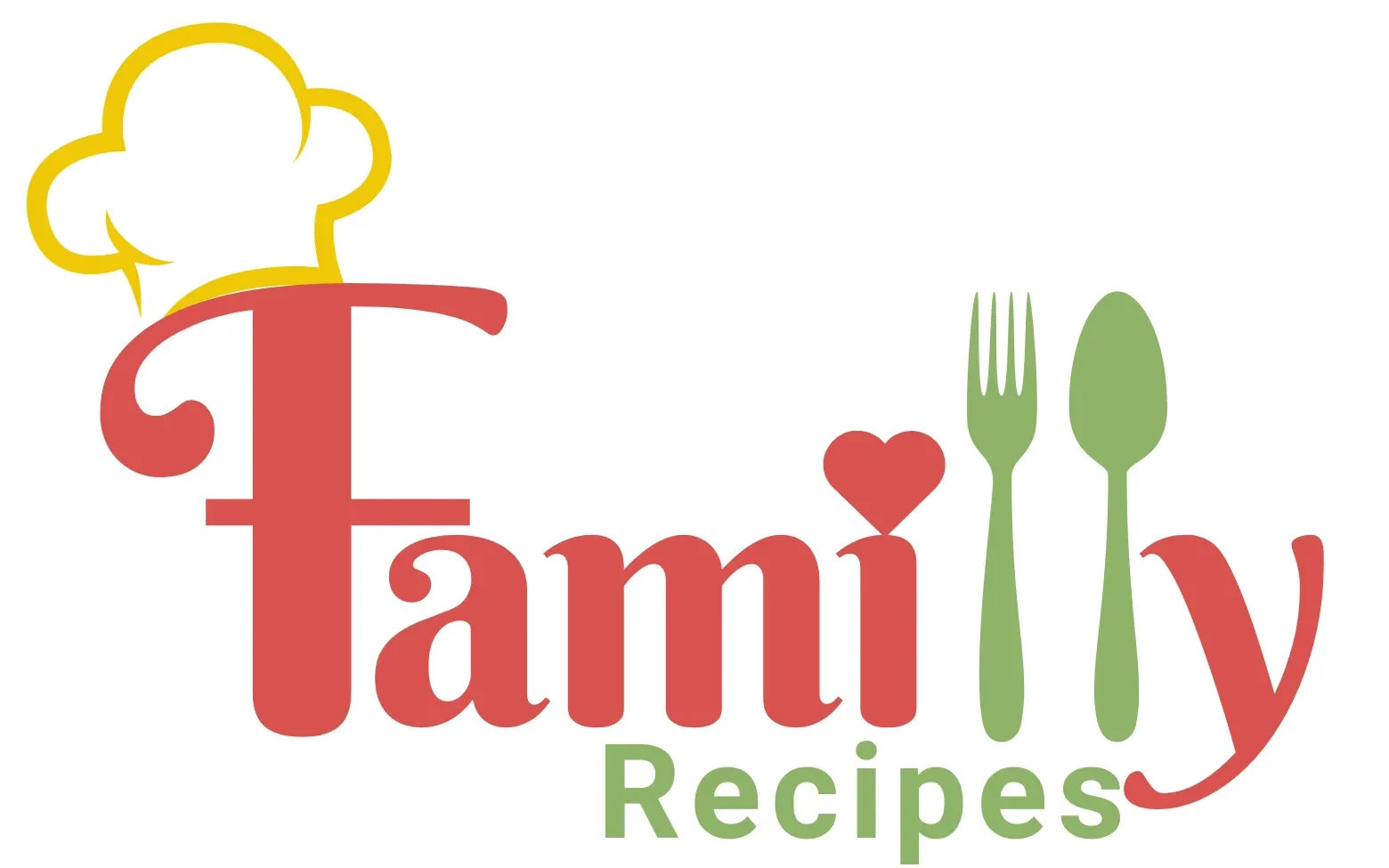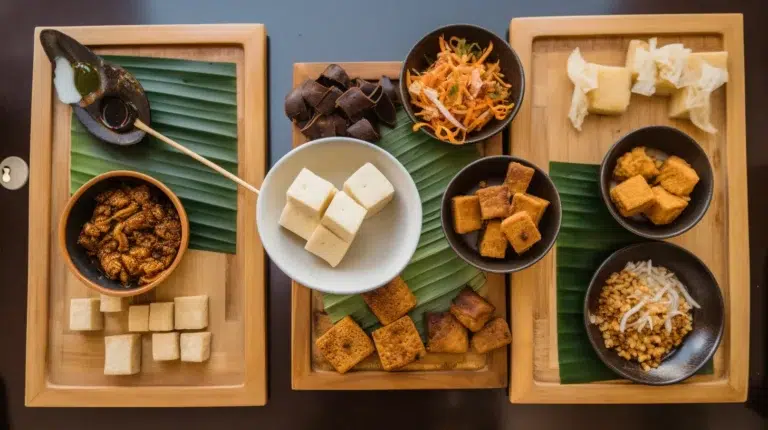
Tofu vs Tauhu—what’s the real difference? Many people confuse these two soy-based protein sources, but they are not the same. While both are made from coagulated soy milk, they differ in taste, texture, production, and usage.
If you’re wondering what is the difference between tofu and tauhu, this guide will provide 10 key differences you should know. We’ll also compare their nutritional values, cooking methods, and best dishes to help you decide which one is right for you.
Table of Contents
Table of Contents
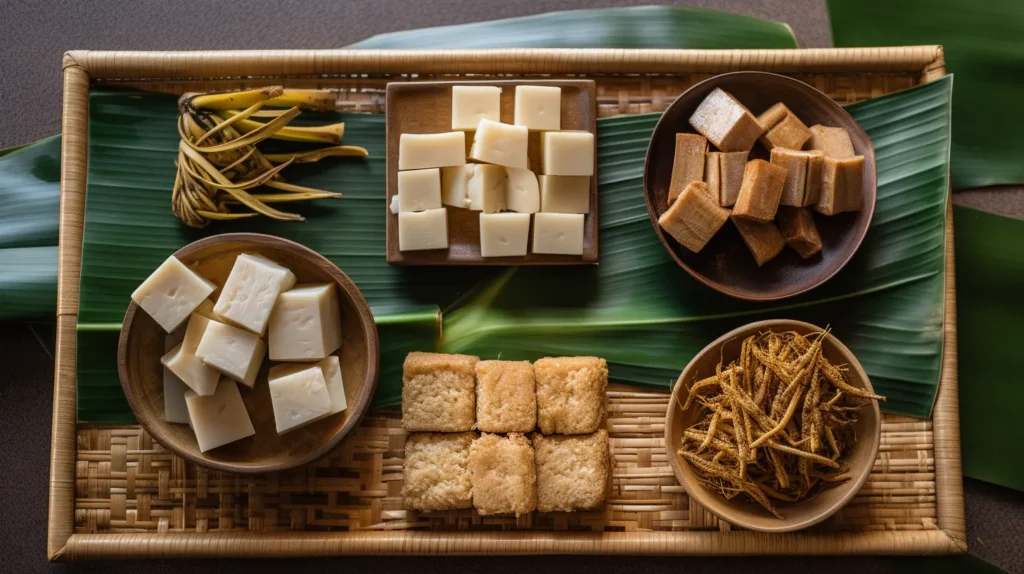
What is Tofu?
Tofu, also called bean curd, is a plant-based protein made by curdling soy milk and pressing the curds into blocks. This 2,000-year-old ingredient originated in China and later spread to Japan and Korea.
Types of Tofu
There are several varieties of tofu, each with unique textures:
- Silken Tofu – Soft and creamy, perfect for soups and desserts.
- Firm Tofu – Holds shape well, great for stir-fries and pan-frying.
- Extra-Firm Tofu – Denser texture, excellent for grilling and baking.
- Fermented Tofu – Aged tofu with an umami-rich taste, often used in sauces.
Tofu is versatile and commonly used in Chinese, Japanese, and Korean cuisines. Read more about the history of tofu.
What is Tauhu?
Tauhu is tofu’s Southeast Asian counterpart, mainly used in Malaysia, Indonesia, and Singapore. The name “Tauhu” comes from Hokkien dialect and refers to soybean curd.
How Tauhu is Different
Unlike tofu, tauhu:
- Has a denser and firmer texture
- Is fried more frequently, giving it a crispier outside
- Has a slightly nutty flavor, often enhanced with spices
- Is used in street food and traditional Southeast Asian dishes
Want to compare their nutritional values? Check out this detailed breakdown of tofu.
Production Process: Tofu vs Tauhu
The production method is one of the biggest differences between tofu and tauhu.
How Tofu is Made
- Soybeans are soaked and ground into a fine paste.
- Soy milk is extracted, separating liquid from solids.
- Coagulation agents (like calcium sulfate or magnesium chloride) are added.
- Curds are pressed into blocks, forming different textures (silken, firm, or extra-firm).
How Tauhu is Made
- Soybeans are processed similarly to tofu.
- Instead of calcium sulfate, a different coagulant is used (gypsum or vinegar).
- Less water is removed, making tauhu denser.
- It is deep-fried immediately, giving it a crispy golden crust.
Taste & Texture Comparison
| Aspect | Tofu | Tauhu |
|---|---|---|
| Texture | Soft to firm | Denser and firmer |
| Taste | Neutral | Slightly nutty |
| Common Cooking Methods | Steamed, baked, stir-fried | Deep-fried, grilled, stuffed |
| Best Used In | Salads, soups, curries | Street food, spicy dishes |

Tofu vs Tauhu: The Surprising Truth About Their Differences!
Ingredients
Equipment
Method
- Understand Their Origins:
- – Tofu originates from China and is widely used in Japan and Korea.
- – Tauhu is Southeast Asian (Malaysia, Indonesia, Singapore) with a firmer texture and nuttier flavor.
- Compare Textures & Taste:
- – Tofu: Soft to extra-firm, mild and neutral in flavor.
- – Tauhu: Denser and slightly nutty, often fried or grilled.
- Cooking Styles:
- – Tofu: Best for soups, salads, stir-fries, or desserts.
- – Tauhu: Perfect for deep-frying, stuffing, or pairing with spicy sauces.
- Nutritional Notes:
- – Tofu (100g): ~76 kcal, 8g protein, 4.8g fat.
- – Tauhu (100g fried): ~150 kcal, 7g protein, 9g fat.
- – Both are rich in plant protein and calcium, but tofu is lighter in calories.
- Choosing Between Them:
- – Use tofu for creamy, mild dishes (soups, curries, desserts).
- – Use tauhu for crispy, bold recipes (street food, grilled skewers, spicy sauces).
- Flavor Pairing Tips:
- – Both pair beautifully with soy-based marinades, chili oil, peanut sauce, or sweet-sour glazes.
- – Try this twist: tauhu goreng with chili peanut sauce or tofu stir-fry with garlic soy glaze.
Notes
– For a tauhu-like texture, use extra-firm tofu and bake or air-fry it.
– Avoid deep-frying if you prefer a lower-fat version — try grilling or baking instead.
– Both tofu and tauhu are excellent plant-based proteins that fit into vegan and vegetarian diets.
Popular Dishes Using Tofu vs Tauhu
Common Tofu Dishes
- Chinese Mapo Tofu (spicy tofu with minced meat)
- Japanese Agedashi Tofu (deep-fried tofu in soy sauce)
- Korean Sundubu Jjigae (soft tofu stew)
Popular Tauhu Dishes
- Tauhu Goreng – Fried tauhu with peanut sauce
- Tauhu Sumbat – Stuffed tauhu with vegetables
- Tauhu Bakar – Grilled tauhu with chili sauce
For dipping sauces, try this seafood boil sauce recipe, which pairs well with tauhu.
Nutritional Comparison: Tofu vs Tauhu
Both are nutrient-dense, but there are key differences:
| Nutrient | Tofu (100g) | Tauhu (100g, fried) |
|---|---|---|
| Calories | 76 kcal | 150 kcal |
| Protein | 8g | 7g |
| Fat | 4.8g | 9g |
| Carbs | 1.9g | 4g |
| Calcium | 350mg | 300mg |
Health Benefits
✔️ Both are high in protein, making them great for vegetarians.
✔️ Tofu has lower fat, making it a healthier choice.
✔️ Tauhu is richer in flavor, but higher in calories due to frying.
Can You Use Tofu and Tauhu Interchangeably?
Yes, but it depends on the texture and cooking requirements of your dish.
- Use Tauhu: If a recipe requires crispiness or a firm structure, tauhu is the better choice. Its dense texture holds up well in deep-frying, grilling, or stuffing, making it ideal for dishes like tauhu goreng or skewers.
- Use Tofu: When you need a softer, creamier texture, such as in soups, smoothies, or creamy sauces, tofu is the preferred option. Silken or soft tofu blends easily and absorbs sauces beautifully.
💡 Pro Tip: If you only have tofu but want a firmer result, opt for extra-firm tofu and press out as much moisture as possible before cooking. Similarly, baking tofu can add a crispy texture similar to tauhu.
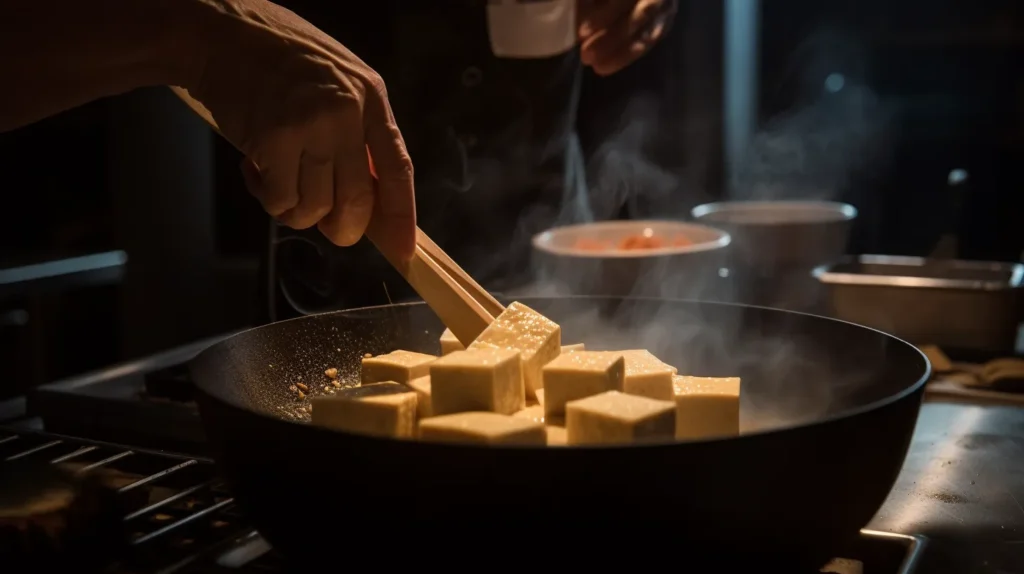
Common Myths About Tofu vs Tauhu
Tofu and Tauhu often get confused due to their shared soy-based origin, but they are far from identical. Let’s clear up some of the most common myths surrounding these popular plant-based proteins:
❌ Myth 1: Tofu and Tauhu Are the Same Thing
✅ Truth: While tofu and tauhu are both made from coagulated soy milk, their texture, production, and culinary uses are quite different.
- Tofu is typically softer and more delicate, available in textures ranging from silken to extra-firm. Its mild flavor allows it to absorb marinades and sauces, making it versatile for soups, stir-fries, and even desserts.
- Tauhu, on the other hand, is firmer and denser, with a slightly nutty flavor. It’s often deep-fried or grilled, creating a crispy exterior while maintaining a soft interior.
💡 Fun Fact: In Southeast Asia, tauhu is frequently served as street food, whereas tofu enjoys broader global popularity as a health-conscious choice.
❌ Myth 2: Tauhu Is Just Deep-Fried Tofu
✅ Truth: The difference between tofu and tauhu goes beyond frying. Their production methods and textures set them apart.
- Tofu Production: Tofu is made by coagulating soy milk using agents like calcium sulfate or magnesium chloride and pressing it into blocks. The moisture content determines its texture (silken, firm, or extra-firm).
- Tauhu Production: Tauhu often uses gypsum or vinegar as coagulants, which results in a denser, firmer curd. Less water is removed during production, and it’s commonly fried to enhance its texture and flavor.
Because tauhu is naturally denser, it holds up better under high-heat cooking methods like deep-frying and grilling, making it ideal for dishes like tauhu goreng and tauhu bakar.
❌ Myth 3: Tofu Is Healthier Than Tauhu
✅ Truth: Both can be nutritious when prepared properly, but the cooking method plays a key role.
- Tofu is typically lower in fat and calories, especially when consumed raw or steamed.
- Tauhu, due to its common preparation method (deep-frying), tends to be higher in calories and fat. However, when grilled or baked, tauhu can be a healthier alternative.
💡 Pro Tip: For a healthier option, avoid deep-frying tauhu and opt for air frying or baking instead.
❌ Myth 4: Tofu Has No Flavor, While Tauhu Is Always Flavorful
✅ Truth: Both tofu and tauhu are relatively neutral in taste, but their ability to absorb flavors depends on the cooking technique.
- Tofu’s neutral taste makes it a blank canvas for bold marinades and sauces.
- Tauhu’s firmer structure allows it to retain a stronger natural soy flavor, especially when grilled or fried.
Understanding the differences between tofu and tauhu can help you choose the right ingredient for your dish. Both offer unique textures, flavors, and culinary possibilities, making them versatile staples in Asian and plant-based cooking. Want to see how tauhu works with sauces? Check out top 10 sauces for seafood that pair surprisingly well with fried tauhu!
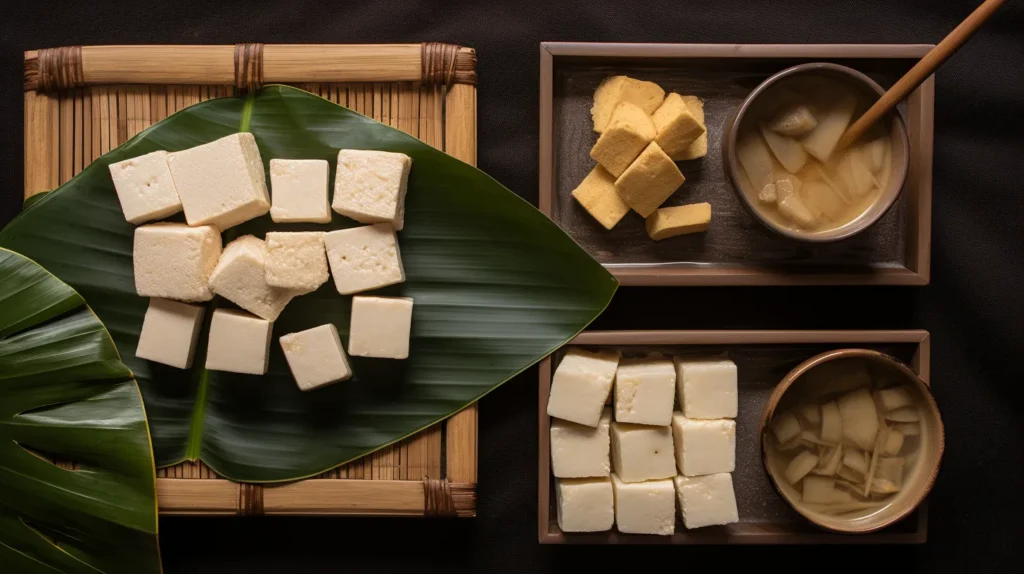
FAQs: Tofu vs Tauhu
Can I Replace Tofu with Tauhu?
Yes, but it depends on the dish you are preparing.
- Tauhu is firmer and denser, making it ideal for deep-frying, grilling, and stir-frying without breaking apart. It also absorbs flavors more effectively during cooking, which is perfect for heavily spiced dishes like tauhu goreng.
- Tofu, especially the silken or soft varieties, is better suited for soups, smoothies, and creamy dishes due to its delicate texture.
💡 Tip: For dishes requiring structure, like skewers or stir-fries, choose extra-firm tofu or tauhu for the best results.
Which Is Healthier: Tofu or Tauhu?
Tofu is generally considered healthier due to its lower calorie and fat content.
- Tofu: A 100-gram serving of firm tofu contains around 76 calories and 4.8 grams of fat, making it ideal for those focusing on weight loss or heart health.
- Tauhu: Due to its common preparation method (deep-frying), tauhu often has higher calories and fat content—approximately 150 calories per 100 grams when fried.
💡 Pro Tip: To make tauhu healthier, consider baking, air-frying, or grilling instead of deep-frying.
Is Tauhu Always Fried?
Not necessarily. While deep-fried tauhu is popular in Southeast Asian cuisine, grilled, baked, or even steamed tauhu are also common in healthier recipes. Tauhu can absorb spices and marinades beautifully even without frying.
Can Tofu and Tauhu Be Used in Desserts?
Yes, tofu is more commonly used for desserts due to its creamy and neutral flavor, especially silken tofu in smoothies, puddings, or vegan cheesecakes.
Tauhu is less popular for desserts but can be creatively used in stuffed sweet recipes or lightly fried with a sugar glaze.
Would you like specific dessert recipes using tofu or tauhu? 😊.
Final Thoughts: Which One Should You Choose? Tofu vs Tauhu
Both tofu and tauhu are excellent plant-based protein options, but the best choice depends on your culinary needs and personal preference.
- ✔️ Use tofu if you’re looking for a soft, creamy texture and a neutral flavor that absorbs marinades beautifully. It’s perfect for soups, salads, and stir-fries.
- ✔️ Choose tauhu when you want crispy, firm textures that hold up well to frying, grilling, or stuffing. Tauhu’s natural density makes it ideal for bold, spiced dishes.
💡 Want to elevate your tauhu or tofu dishes? Try pairing them with a bold dipping sauce. Check out this top 10 sauces for seafood—some of these sauces work perfectly with fried tauhu!
Ready to experiment in the kitchen? Whether it’s tofu or tauhu, these versatile ingredients will take your plant-based meals to the next level. 😊
